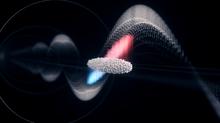
Subscribe to our mailing list
Stay up to date on new Press Releases from our members.
See our Privacy Policy
From the Labs

DESY scientists achieve breakthrough in laser-alignment for macromolecular single-particle imaging
Single-particle diffractive imaging (SPI) using X-ray free-electron lasers allows researchers to ...

Computer Security: ThisIsAVeryGoodPassword
Let’s give up the complexity rules (letters, symbols, numbers) and go for long passwords, i.e....

ATLAS gets under the hood of the Higgs mechanism
The detection of longitudinally polarised W boson production at the Large Hadron Collider is an i...

A milestone for laser plasma acceleration
Laser plasma acceleration is a potentially disruptive technology: It could be used to build far m...

New projects represent further £4 million investment in net zero

New Director of the Isaac Newton Group of Telescopes announced

Vampires combine fear, laughter and entertainment
As a remake of the 1922 film Nosferatu was recently released, the sociologist Arnaud Esquerre tak...

Knitted fabric, an everyday metamaterial
Light, soft, resistant, deformable, and sometimes tacky, knitted fabric is not just an everyday o...

CTAO, the gamma-ray observatory becomes a European Research Infrastructure Consortium

First observation of the nuclear two-photon decay in bare atomic nuclei

Students share work at SNOLAB Student Talk Competition

Nikhef wishes you an amazing 2025
Management and staff of the National Institute for Subatomic Physics Nikhef wish you a prosperous...

12 days of SNOLAB science

NWO-XL grants for three groundbreaking research lines at Nikhef
Three Nikhef projects receive funding from NWO within the ENW-XL Open Competition....

The quantum chase
Some friendly competition between the CMS and ATLAS experiments led up to the first discovery of ...

Customizable quantum control toolkit developed at Fermilab ready for commercial production
The Quantum Instrumentation Control Kit now features updated software and firmware and new compan...

Members of the Royal Swedish Academy of Sciences visit the LNF
On November 15th, members of the Royal Swedish Academy of Sciences of the Physics Class visited t...

QUAX’s first step towards the haunt for axions
A significant milestone in the search for dark matter has been achieved at the INFN Frascati....

Argonne engineers develop one-of-a-kind instruments and facilities for scientific discovery

Aurora supercomputer heralds a new era of scientific innovation

SURF Plans Long-Term Future with Call to Global Scientific Community
SURF is seeking input from the global underground science community in a new outreach effort to e...

Four Elected to SURF User Association Executive Committe
The association recently elected four executive committee members.
...
Dark Energy Spectroscopic Instrument (DESI) Creates Largest 3D Map of the Cosmos
The Dark Energy Spectroscopic Instrument (DESI) has capped off the first seven months of its surv...

New theory finds upcoming satellite mission will be able to detect more than expected

Taking on decarbonization in the ag sector: ORNL summit highlights focus areas
Energy and sustainability experts from ORNL, industry, universities and the federal government re...

Measuring trust in AI

Week 52 at the Pole
Last week was the “last” (52nd) week of the year at the South Pole, and as usual, there was a lot...

Scientists use Summit supercomputer, deep learning to predict protein functions at genome scale
A team of scientists led by the Department of Energy’s Oak Ridge National Laboratory and the Geor...

First realistic portraits of squishy layer that’s key to battery performance
Cryo-EM snapshots of the solid-electrolyte interphase, or SEI, reveal its natural swollen state a...

Dr. Nur Ika Puji Ayu, SOKENDAI, received School of High Energy Accelerator Science Dean’s Award
In September 2021, Dr....

Revitalizing batteries by bringing ‘dead’ lithium back to life
Islands of inactive lithium creep like worms to reconnect with their electrodes, restoring a batt...

Week 51 at the Pole
A lot happened at the Pole last week, even though there aren’t a lot of pictures to show for it.<...

SuperKEKB has renewed the luminosity world records again!
The 2021c run of SuperKEKB started on October 19th and ended successfully on December 23rd....

Technique Tunes Into Graphene Nanoribbons’ Electronic Potential
Technique Tunes Into Graphene Nanoribbons’ Electronic Potential...

Precise Electromagnetic Structure of Neutron Measured at BESIII
The BESIII collaboration has presented measurements of the neutron's electromagnetic (EM) st...

CSNS Accelerator Begins Beam Commissioning After Summer Maintenance
The CSNS accelerator successfully completed its 2021 summer maintenance and began a new round of ...

Canadian-built laser chills antimatter to near absolute zero for first time
Researchers with the CERN-based ALPHA collaboration have announced the world’s first laser-based ...

Dr. Nigel Smith appointed as next Director of TRIUMF
Dr. Nigel Smith has been selected to serve as the next Director of TRIUMF.
...2025 Global Physics Photowalk
Several of the world’s leading science laboratories will open their doors to amateur and professional photographers as they join together to host the Global Physics Photowalk competition.
The Photowalk will give participants a rare opportunity to visit and photograph physics facilities in Asia, Europe and North America — and to get a behind-the-scenes look at where the world’s most exciting science is being carried out today.
Follow the Photowalk on social media with #PhysPics25
































